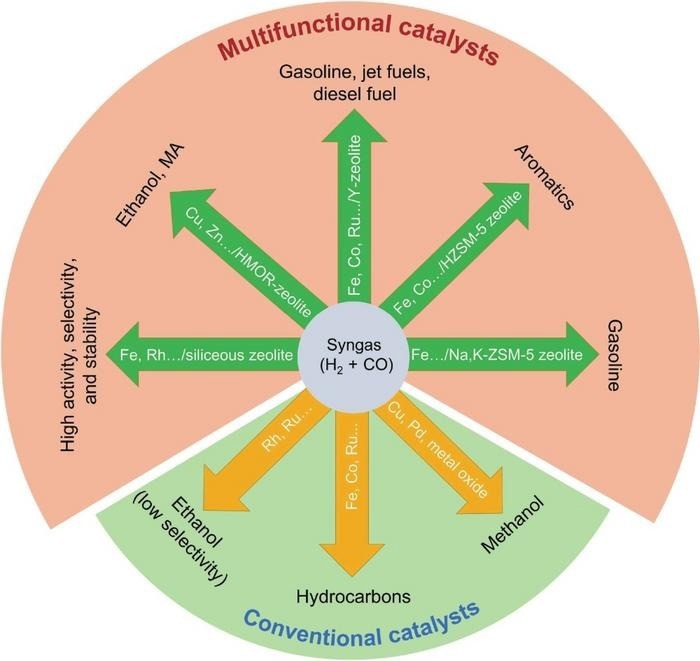Today’s fuels rely mainly on petroleum. Scientists are exploring for ways to manufacture fuels that do not require petroleum as demand rises. A team of researchers set out to investigate the function of zeolites in the conversion of synthetic gas to fuel. They evaluated the most recent advances in synthetic gas conversion with zeolites-containing catalysts to better understand how zeolites govern the reaction pathways.

The illustration shows a strategy for the transformation of syngas over conventional and multifunctional catalysts. The zeolite effectively optimizes the reaction pathways beyond the classical Fischer-Tropsch synthesis process. Image Credit: Carbon Future, Tsinghua University Press
On July 28th, 2023, their review paper was published in the journal Carbon Future.
For a long time, scientists have turned to synthetic gas, or syngas, as an alternative to petroleum-based fuels. Syngas is a carbon monoxide and hydrogen gas combination that can be easily created from coal, natural gas, and biomass. Scientists have been researching the conversion of syngas into lucrative fuels and chemicals for over a century.
The Fischer-Tropsch synthesis (FTS) is a successful method used by scientists to convert syngas into hydrocarbons. Franz Fischer and Hans Tropsch devised this common conversion method in the 1920s.
A sequence of chemical reactions creates hydrocarbons in this process. To evaluate the selectivity of this FTS process, scientists employ a variety of models. The Anderson-Schulz-Flory (ASF) model is the most basic and extensively utilized.
The standard FTS approach produces restricted products that comply with the Anderson-Schulz-Flory model. For example, olefins, alkanes, and gasoline fractions have low content values of roughly 58% and 48%, respectively. Scientists require a method to optimize the product distributions resulting from the FTS process. Nonetheless, this remains a difficulty.
Scientists discovered that zeolite efficiently optimizes reaction routes beyond the standard FTS approach. Zeolites are minerals that are hydrated aluminosilicates. They are solids with a three-dimensional crystal structure that allows them to efficiently absorb and expel liquid.
The zeolite controls the reaction process. Scientists have used zeolites to increase the selectivity of gasoline, jet fuel, and diesel. These results outperform those obtained with the Anderson-Schulz-Flory model. Using zeolite catalysts, they have also produced a number of aromatic compounds.
In light of these results, we thought it was appropriate to review and discuss the recent advancements in the significance of zeolites in syngas conversion.
Liang Wang, Professor, College of Chemical and Biological Engineering, Zhejiang University
The study team went through the newest developments in FTS over catalysts made of zeolites. In addition, they looked at the function of zeolites and how their structure and performance interact.
Wang added, “Based on the catalytic mechanism, it is expected that the rational design of zeolites will be helpful for the development of more effective catalysts and reaction processes.”
The team’s research revealed that zeolite efficiently improves the reaction pathways outside of the traditional FTS procedure. They think the market for syngas conversion assisted by zeolites is still expanding.
They offer numerous suggestions for topics on which future research could concentrate. In conjunction with the FTS catalyst, aluminosilicate zeolites have predominated up until this point. The group suggests that future research should take more zeolite characteristics into account.
Advances in in situ characterizations and theoretical modeling techniques have been extremely helpful to researchers studying the structure-activity connection of catalytic materials at the atomic scale. The team suggests that future study in this field concentrate on fusing large data with artificial intelligence.
By narrowing their attention in this way, researchers will be better able to comprehend the fundamental processes and create catalyst structures.
Wang concluded, “This will provide the foundation and research direction for understanding the reaction mechanism, and finally designing the corresponding zeolites.”
Hangjie Li, Liang Wang, and Feng-Shou Xiao from the Key Lab of Biomass Chemical Engineering of Ministry of Education, College of Chemical and Biological Engineering, Zhejiang University are also part of the research team.
The National Key Research and Development Program of China and the National Natural Science Foundation of China provided funding for the study.
Journal Reference:
Li, H., et al. (2023) Importance of zeolite in multifunctional catalysts for syngas conversion. Carbon Future. doi:10.26599/CF.2023.9200003
Article Revisions
- Jan 6 2025 - Meta Description has been updated to fall inline with Google recommendations and a malformed link has been repaired.